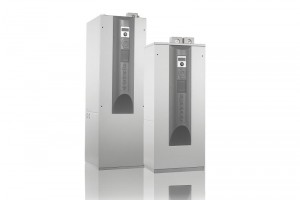The principle of a heat pump is very simple. It uses low-temperature solar and geothermal energy accumulated in the soil and groundwater. The earth heats up slowly  and stores energy through spring, summer and autumn as a battery. Consequently, the stored energy is so large that it is easily sufficient to heat the house in winter. This takes place as follows: low-temperature heat from the ground or water is passed through the evaporator to the installed pump. The pump is filled with low-boiling liquid which turns into a gas. The heated gas is compressed by a pump compressor which raises the temperature significantly. In the condenser the water is then heated which fills the heaters and cooled fluid flows through the expansion valve back into the evaporator, and the entire process begins again. The task of a pump is, therefore, transferring (not producing) a heat from the low-temperature source (lower heat source) to a higher temperature source (upper source, for example,underfloor heating).
and stores energy through spring, summer and autumn as a battery. Consequently, the stored energy is so large that it is easily sufficient to heat the house in winter. This takes place as follows: low-temperature heat from the ground or water is passed through the evaporator to the installed pump. The pump is filled with low-boiling liquid which turns into a gas. The heated gas is compressed by a pump compressor which raises the temperature significantly. In the condenser the water is then heated which fills the heaters and cooled fluid flows through the expansion valve back into the evaporator, and the entire process begins again. The task of a pump is, therefore, transferring (not producing) a heat from the low-temperature source (lower heat source) to a higher temperature source (upper source, for example,underfloor heating).
In order to achieve 100% of heating power the heat pump uses approximately 70% of the energy contained in the ground or in the air and 30% of electrical energy. The heat pump can be used not only for heating but also for preparing domestic hot water and even for cooling (”pumps with reverse”). For more information about the types of heat pumps, lower heat sources and geothermal drilling for heat pumps in GRD technology (Geothermal Radial Drilling), go to: KNOWLEDGE BASE (link to the page).
A parameter, which compares the performance of heat pumps is the COP (Coefficient of Performance). It tells how much free heat from the natural environment the device uses in relation to current consumption. In other words, it determines the efficiency of a pump.
COP =Q / Qe (Q- heat passed during measurement, Qe- electricity consumption
during the measurement).
A heat pump works most effectively when the COP reaches a maximum value, which is closely related to two temperatures 1) at input to the heat pump from a lower source and 2) at the power supply of the heating system. The smaller the difference between these temperatures, the greater the efficiency of the pump.
Examples of heat pump symbols: BO/W35,W10/W35, A2/W35. The method of determining their parameters is presented below:
1. capital- medium of lower heat source
B=Brine
W=Water
A= Air
E=Earth
2. digit or number- temperature of the lower heat source
3. capital-medium of heat receiver (upper heat source)
W= Water( heating water)
4. number-temperature of upper heat source(35=35°C at the power supply)
According to PN-EN 14511 standard minimum required values of COP for heat pumps are:
heat pump type min. COP according to EN14511-2
brine/water: B0/W35 4.30
water/water: W10/W35 5.10
air/water: A2/W35 3.10
direct evaporating in soil/water: E4/W35 4.30
The theoretical maximum value of COP is 9. This value is unattainable in practice. For example, for brine/water heat pumps of different manufacturers, COP is from approximately 4.0 to 5.0 for parameter B0W35.
Very high values of COP that deviate from the required EN 14511 standard can be found in various promotional brochures or technical data of heat pumps. This problem is very important because a number of customers decide to choose a particular device based on the COP coefficient specified by the manufacturer.
Examples of dishonest market practices (“improving” the performance of devices):
– administration of COP according to outdated PN-EN255 standard and not in compliance with the current one PN-EN14511,
– determination of COP without giving parameters of lower and upper source,
– administration of COP without including the electricity consumed by the circulation pump of central heating (PN-EN 14511 standard always takes into account electricity as part of the circulation pump associated with hydraulic resistance of condenser),
– determination of COP without taking into account circulation pumps of lower and upper source; it also applies to the situation when all circulation pumps are built into the heat pump (sometimes there is a postscript “the COP value according to PN-EN 14511 standard, but excluding the circulation pumps of upper and lower source”),
– high COP for devices without built-in pumps of lower and upper sources(as part of the tests the device is examined with an additional circulation pump),
– the highest possible COP value-without specifying any additional information about the parameters of lower and upper heat source, hoping the customer won’t ask for the conditions and standards in which the measurement was taken.
Currently, in accordance with standards, heat pump manufacturers must specify the COP value on the nameplate for parameters:
COP for A2W35 for air/water heat pump,
COP for B0W35 for brine/water heat pump,
COP for W10W35 for water/water heat pump,
COP for E4W35 for direct evaporating in the ground/water heat pump.
This value is given after the manufacturer has conducted his own studies or they are carried out by the accredited research unit according to ISO 17025 standard and recognized by EHPA (European Heat Pump Association).
The most honest manufacturers, however, publish charts for the entire operating temperature range of their heat pumps.



